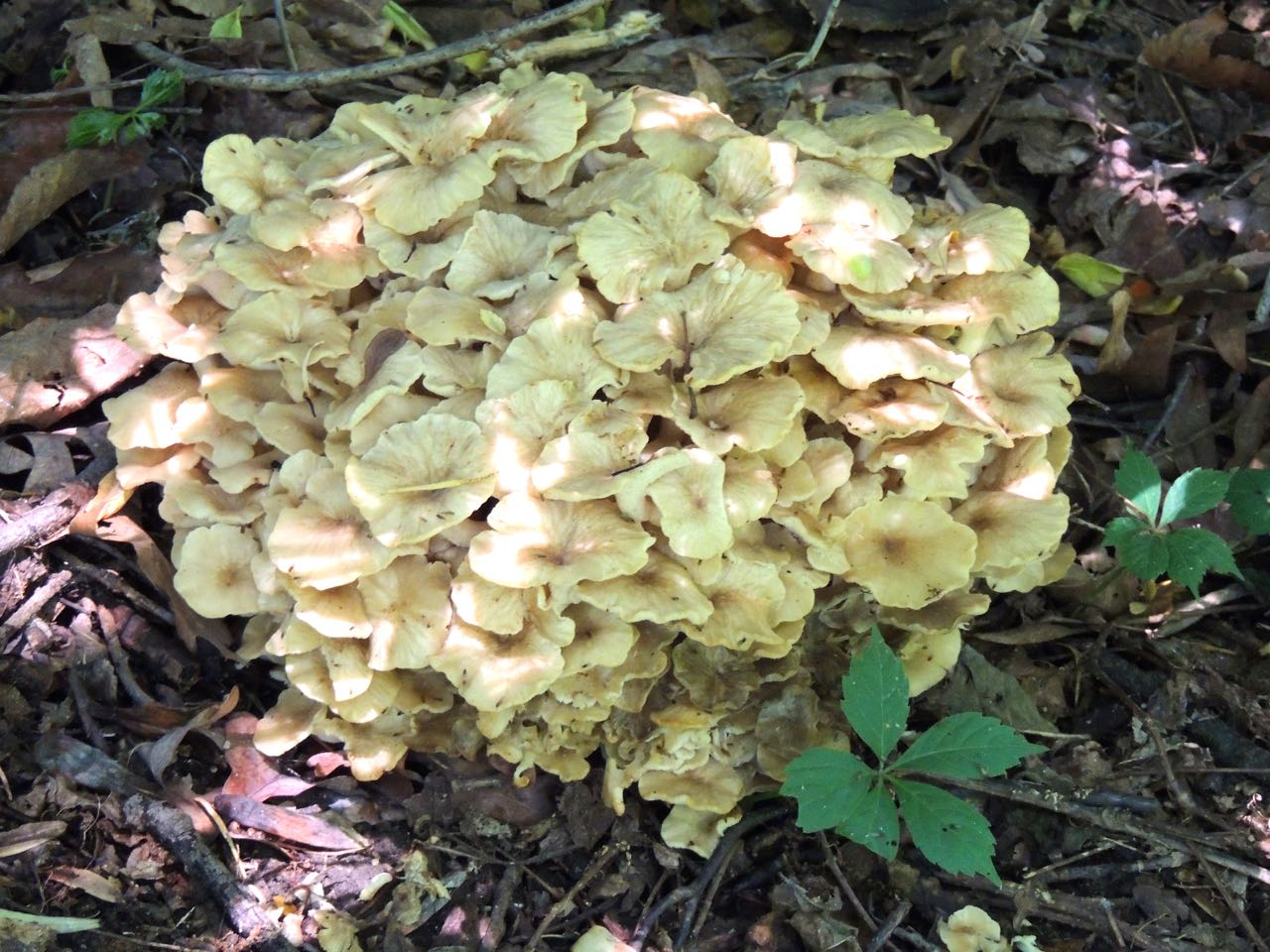Magic Mushrooms
Bill Young
The Washington metro area had a record amount of rain in 2018, causing a lot of mushrooms and other fungi to grow in Monticello Park. In 2019, some special mushrooms were found on a trail leading up to the knoll. Their scientific name is Polyporus umbellatus, and they are commonly known as either Lumpy Brackets or Umbrella Polypores. They are considered rare, and they grow on the roots of oak and beech trees. Polyporus umbellatus has a large fruit body which is between the size of a head of cabbage and a volleyball. The fruit body is covered with hundreds of caps.

There are an estimated 2.8 to 5 million species of fungi in the world, and of these, only 130-140,000 have been named. That means at least 95 percent of the fungi in the world have not been classified by scientists. (The scientific study of fungi is called mycology.) Fungi are classified in a separate kingdom from plants, animals, or bacteria. Only about 11 percent of fungus species produce mushrooms, which are short-lived fruiting bodies that produce spores in huge abundance. The mushroom is only one part of a fungus, just as a flower is only one part of a plant. The main body of the mushroom-producing fungus is underground. Many fungi do not produce fruiting bodies.
The fungus kingdom is incredibly diverse, and fungi exist almost everywhere, both indoors and outdoors. They are capable of colonizing virtually anywhere, and their ability to grow in tiny places is a key to their success. They can be either single-celled or multi-celled. Yeasts are single-celled fungi which we use to make bread. Fungi are used in making beer, wine, and cheese. Some are used to make antibiotics, such as penicillin. Were it not for fungi, the surface of the Earth would be covered with dead things. Humans have fungi on their skin.
Without fungi, life on the Earth would be very different. They were responsible for the development of green plants on land 450 million years ago. The Earth is thought to be about 4.5 billion years old, which means that it had no terrestrial green plants for the first 90 percent of its existence. Plants growing in water have numerous ways to collect nutrients. The same is not true for land plants with primitive root systems. Fungi on land can spread out their roots to absorb water and minerals. They developed a symbiotic relationship with plants, giving them water and minerals in exchange for the sugars produced by the plants. About 90 percent of plant species have these relationships with fungi, including the major crops used by humans for food. Many types of fungi also protect plant roots from pathogens in the soil. And some types of fungi give plants the ability to colonize very saline soils.
Some fungi have developed symbiotic relationships with animals. Termites and leafcutter ants capitalize on the ability of fungi to break down materials and actually farm fungi. The fungi get the food brought by the termites, and in return, the termites get the broken down food which they can eat. My YouTube channel has a video showing how leafcutter ants in Panama farm fungi.
In some ways, fungi are more like animals than plants. They have a substance called chitin in their cell walls. Chitin is also in the external skeletons of arthropods, as well as in the cells of other animals. Most plants create their own food, through photosynthesis. Fungi cannot do this, and like animals, must seek external food sources. Their method for breaking down food is almost the exact opposite of the one used by animals. An animal consumes food and internally has enzymes to break it down so that it can use the nutrients. Fungi secrete enzymes to break down their food molecules outside of their bodies so that they can more easily consume the smaller molecules. This strategy is risky, because other organisms can steal the broken-down products.
Many fungi are not beneficial. Some are parasites, and many do serious damage to the human food supply. Between a tenth and a quarter of crops are lost each year due to fungal diseases while they are growing, and up to another 20 percent are lost after they are harvested. Fungi have caused severe damage to trees, with the most notable instances being from Dutch Elm Disease and Chestnut Blight. More than a million people die each year from skin infections caused by fungi — this number is greater than the deaths caused by HIV and tuberculosis combined. Many allergy sufferers experience discomfort from fungal spores in the air. And climate change is promoting the movement of fungi into new areas, which could have serious implications for food security on the planet.
The next time you are wandering along the paths of Monticello Park looking for birds and plants, be sure to keep your eyes open for fungi. They often are well hidden, but occasionally, you will stumble on some special ones such as the Polyporus umbellatus. To learn more about fungi, you can listen to recordings on the following BBC radio shows: In Our Time and The Life Scientific. You can also look at an article about the discovery of the world's oldest known fungi in Deutsche Welle.
